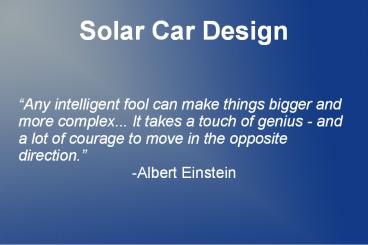Solar Car Design - PowerPoint PPT Presentation
Title:
Solar Car Design
Description:
Any intelligent fool can make things bigger and more complex ... Triangles Usually welded metal Aluminum Steel Tub Usually ... for your application. – PowerPoint PPT presentation
Number of Views:205
Avg rating:3.0/5.0
Title: Solar Car Design
1
Solar Car Design
- Any intelligent fool can make things bigger and
more complex... It takes a touch of genius - and
a lot of courage to move in the opposite
direction. - -Albert Einstein
2
Keep It Simple!
3
Key Ideas To Focus On
- Safety
- Is this safe?
- Reliable
- Must first finish the race.
- Efficient
- Performance Considerations.
- Execution
- Can we do it?
4
Process
- Learn general solar car concepts
- Spends time observing successful executions
- Read Event Rules!
- Work on design
- Read Event Rules!
- A lot of design problems and considerations can
be solved simply by applying the constraints
found in the rules.
5
Overview
- Array Position
- Wheel Layout
- Frame
- Suspension
- Electrical
6
Array Position
- A Few Concepts
- Above Body
- Body Contour
- Below Driver's Head/Canopy
7
Array Position
- Above Body
- No Shadows from Driver or other components.
- Design Freedom below array
8
Array Position
- Body Contour
- Aerodynamic
- Shaded by General Shape of Car
- Many Angles to sun
9
Array Position
- Below Driver's Head
- Shaded by any items above array
- Can be bright for driver
- Driver is exposed to more direct sun without
canopy
10
Flat Array vs. Curved
- Flat Solar Arrays
- Easier to execute
- Angle to sun less of a concern
- Curved Solar Arrays
- Higher the angle the greater chance for breaks
without ideal support. - Angle to sun more of a concern
- Power Tracker Considerations
11
Hybrid Array
- Increase overall array efficiency by placing
higher efficient cells in most optimal position.
12
Wheel Layout
- 3 Wheel
- 2 in front
- 1 in front
- 4 Wheel
13
3 Wheel Layout
- 1 in Front
- Generally less stable
- Unstable in most turns at decent speed
14
3 Wheel Layout
- 2 in Front
- Generally Stable
- Gets it done
- Popular
15
4 Wheel
- Possibly heavier than 3 wheels due to extra
suspension - Potential to provide better support and ride
- Road Debris benefit
16
Frame
- Space Frame
- Triangles
- Usually welded metal
- Aluminum
- Steel
- Tub
- Usually composite
- Carbon Fiber
- Fiberglass
- Tube-like shapes/sections
17
Frame
- Space
- Must be designed to support all necessary loads
18
Frame
- Tub/Composite
- Lighter
- Stronger
- Easier to design
- Harder to execute
- Higher cost
19
Important Cargo
- Driver
- Batteries
- Suspension mounts
- Array mounts
- Motor/Motor controller
20
Suspension
- Do you need one?
- Not necessarily.
- Good idea?
- Solar Cells are fragile
- Road Debris
- Driver Comfort and ultimately Driver Safety
21
Suspension Types
- Double Wishbone
- Popular
- MacPherson Strut or McPherson strut
22
Suspension
- Double Wishbone
23
Suspension
- MacPherson Strut or McPherson strut
24
Electrical
- All solar cars are electric (battery) cars with
an added array. - All solar car main electrical systems look
schematically the same. - Difference is in the details and execution.
25
Electrical
- Solar Cars are cars first, battery
powered/electric cars second, and solar cars
third.
26
Electrical
- Power Trackers
- Converts and optimizes array power for system.
- Not needed, but a good idea.
- High cost.
- Power Tracker for each array string/angle, or one
large Power Tracker for the whole array.
27
Electrical
- Fuses
- Specific Fuse Detailed by Event Rules.
- Add fuses where it makes sense for added safety.
- Switches
- Specific Switches Detailed by Event Rules.
- Add switches when it makes sense for added
safety.
28
Electrical
- AC vs. DC
- We're working with DC.
- Make sure components are DC rated for your
application. - Contact manufacturer or trusted consultant to
make sure your components will work reliably with
your DC application.
29
Electrical
- Wire
- Size wire for worst case scenario.
- Temperature
- Voltage
- Current
- Wire should be capable of carrying more current
than fuses at operating temperatures.
30
Summary
- Keep It Simple
- Safe
- Reliable
- Efficent
31
Questions































